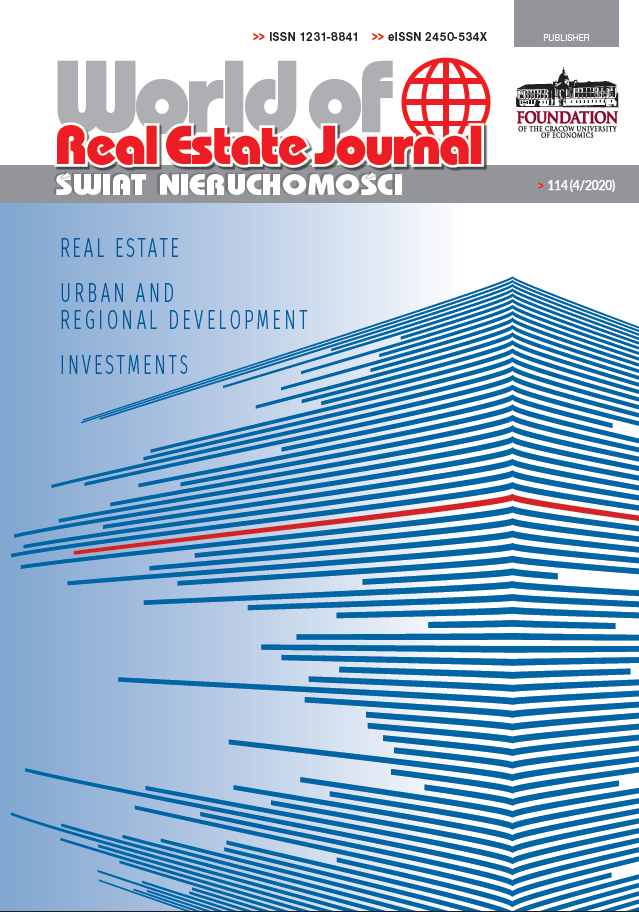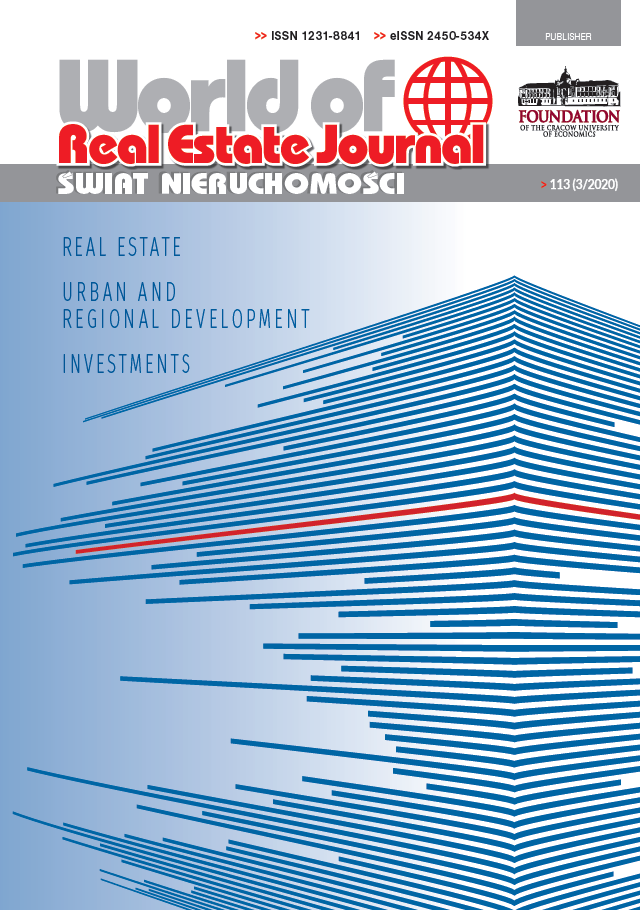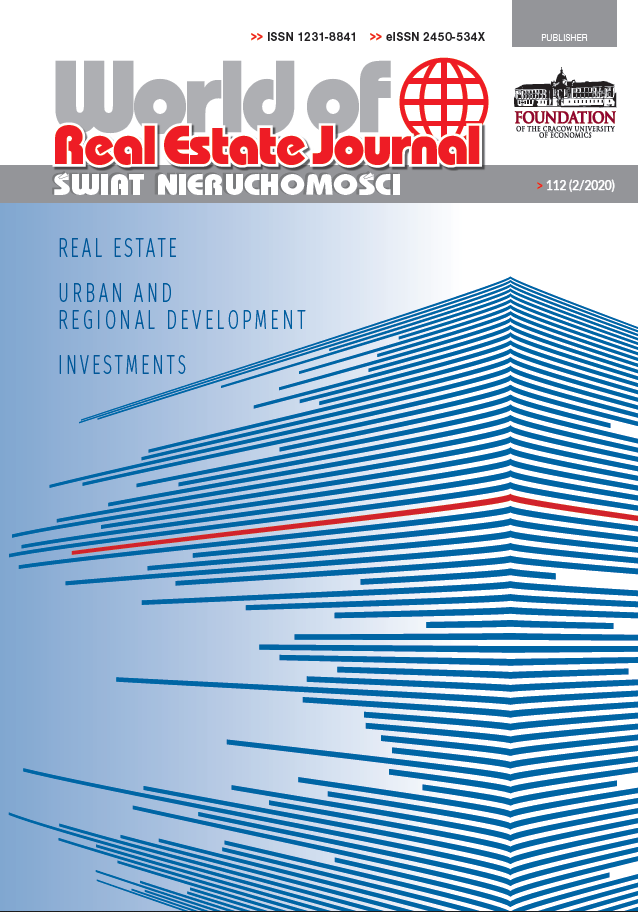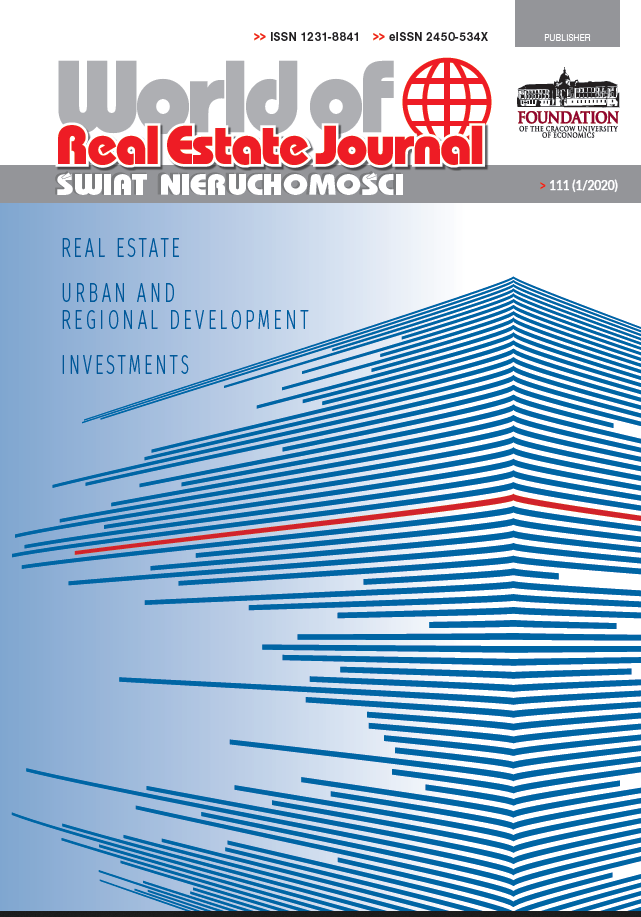MARKET
1) Andrej Adamuscin – An Analysis of the Development of the Office Space Market in Bratislava
2) Stanisław Belniak, Michał Głuszak, Małgorzata Zięba – The Supply of Sustainable Office Space in Poland
3) Ewa Kucharska-Stasiak – Discrepancies in the Interpretation of the Real Estate Market Value.Causes and Consequences
4) George Matysiak – An Analysis of the Accuracy of the UK Commercial Property Forecasts
INVESTMENT
5) Bartłomiej Marona, Michał Głuszak, Adam Nalepka – Investment Attractiveness of Polish Cities in the Context of Local Governments’ Attitude towards Investors
6) Magdalena Załęczna, Agata Antczak – The Relations Between a Developer and his Clients – Remarks About the Polish Institutional Framework
REAL ESTATE MANAGEMENT
7) Maciej W. Wierzchowski – The Characteristics of the Land Use in Polish Cities
HOUSING
8) Daniela Špirková, Koloman Ivanička – The Problems of the Social Rental Housing in Slovakia
CONFERENCES
9) Anna Górska – A Scientific Conference ‘Housing Needs on the Local Housing Market and the Ways of their Satisfaction’ (Poznań, 27th September 2012) DOWNLAND
10) Andrzej Jaki – 17th International Scientific Conference ‘Global and Regional Challenges Concerning Restructuring of Enterprises and Economies’ (Krynica-Zdrój, 17th – 20th October, 2012) DOWNLAND
11) Tomasz Rojek – Doctorate Honoris Causa of Częstochowa University of Technology for Professor Ryszard Borowiecki (Częstochowa, 22nd October 2012) DOWNLAND
WORLD OF REAL ESTATE JOURNAL 2012
12) Table of Contents 2012 DOWNLAND
LIST OF REVIEWER
13) List of Reviewers 2012 DOWNLAND
SUMMARIES
Andrej Adamuscin - An Analysis of the Development of the Office Space Market in Bratislava
The paper presents the results of the analysis of the development of the office space market in Bratislava. The main objective of this paper is mainly to point out the development of the office real estate market in the capital of Slovakia in recent years and to present the current market situation.
Key words: office space market; Bratislava; market analysis
Citation (APA): Adamuscin, A. (2012). An Analysis of the Development of the Office Space Market in Bratislava. Świat Nieruchomości, (4(82)), 4-11.
DOI: 10.14659/worej.2012.82.01
READ ALLStanisław Belniak, Michał Głuszak, Małgorzata Zięba - The Supply of Sustainable Office Space in Poland.
In the article we discuss the concept of sustainable real estate. As can be easily shown the certification systems of ecological solutions in building (LEED, BREEM, DGNB, Green Star, or CASBEE) have been applied in highly developed countries, yet they are rarely found on the nascent office property markets such as Poland. Based on that in the article we analyze the supply of sustainable office space in Poland. We study provision of certified office buildings in Poland both in Central and Eastern Europe context., as well as we discuss regional differences in diffusion of ecologic solutions among polish major cities.
Key words: ecological solutions in building (LEED, BREEM, DGNB, Green Star, or CASBEE); sustainable office space
Citation (APA): Belniak, S., Głuszak, M., Zięba, M. (2012). The Supply of Sustainable Office Space in Poland. Świat Nieruchomości, (4(82)), 12-19.
DOI: 10.14659/worej.2012.82.02
READ ALL Ewa Kucharska-Stasiak - Discrepancies in the Interpretation of Real Estate Market Value. Causes and Consequences.
For thirty years now, institutions responsible for the international shape of valuation standards have sought to harmonize the definitions relevant to the valuation process, the most important being market value. The definition adopted in the International Valuation Standards was consistent with that used in the European Valuation Standards, which was accepted in the European Union. It seemed that these organizations also interpreted this value in a similar way. However, the latest edition of the European Valuation Standards (published in 2012) has revealed a discrepancy. The purpose of this article is to:
- present the ÎÎ existing definitions and interpretations of market value,
- explain the concept of market value adopted in the European Valuation Standards,
- identify the causes and consequences of differences in market value interpretation.
Key words: market value of real estate; highest and best value; hope value
Citation (APA): Kucharska-Stasiak, E. (2012). Discrepancies in the Interpretation of the Real Estate Market Value Causes and Consequences. Świat Nieruchomości, (4(82)), 20-23.
DOI: 10.14659/worej.2012.82.03
READ ALLGeorge Matysiak - An Analysis of the Accuracy of UK Commercial Property Forecasts.
This paper considers the accuracy of UK commercial property forecasts over the period 2000-2011. Using the Investment Property Forum (IPF) consensus data we observe that forecasters tend to display conservatism and avoid ‘big numbers’ in their forecasts. We find that forecasters tend to overestimate capital growth and total rates of return during periods when the market is performing poorly and vice-versa during strong market conditions. A marked difference in the relative accuracy of capital and total returns versus rental figures is also evident in the analysis, with accuracy enhanced in the case of rental forecasts. This would imply that forecasters have greater difficulty in forecasting capital and therefore total returns. In addition, as would be expected, accuracy is dependent on market conditions. O verall, differences in forecast values for capital growth and total returns have increased over the last 4 years.
Key words: commercial property forecasts; UK; Investment Property Forum (IPF)Citation (APA): Matysiak, G. (2012). An Analysis of the Accuracy of the UK Commercial Property Forecasts. Świat Nieruchomości, (4(82)), 24-31.DOI: 10.14659/worej.2012.82.04READ ALLBartłomiej Marona, Michał Głuszak, Adam Nalepka - Investment Attractiveness of Polish Cities in the Context of Local Governments’ Attitude towards Investors.
It is absolutely essential to identify the barriers which hinder realization of investment projects in certain cities or even make it impossible, in order to specify the activities necessary for streamlining the performance of public administrative units in the area of cooperation with investors. Those barriers are, for the large part, created by gminas themselves and their diversified intensity influences the assessment of the investment climate in the towns, thus also the attractiveness of the places. The focus of this article is to analyze barriers in investment projects in Poland, but only those which depend on the district authorities, i.e. which can be directly influenced by those authorities.
Key words: Investment Attractiveness; Poland; Local Governments’ Attitude towards Investors; barriers in investment projectsCitation (APA): Marona, B., Głuszak, M., Nalepka, A. (2012). Investment Attractiveness of Polish Cities in the Context of Local Governments’ Attitude towards Investors. Świat Nieruchomości, (4(82)), 32-37.DOI: 10.14659/worej.2012.82.05READ ALLMagdalena Załęczna, Agata Antczak - The Relations Between a Developer and his Clients – Remarks about the Polish Institutional Framework
After a long battle for a higher level of protection of developers’ clients, this year the Law on the Protection of a Purchaser of a Dwelling against a Developer has been introduced. An assessment of the previous legal situation left no doubt about the legitimacy of enhancing the protection rules, however, reckless filling the gaps of the institutional framework in the form of an unclear regulation may lead to unwanted results. There is a general question how far the state should interfere in the market relations between a developer and his clients. The authors emphasize that a client has also an obligation to think about their own financial security and no legal regulation will take off this responsibility.
Key words: residential market; developer; clients protectionCitation (APA): Załęczna, M., Antczak, A. (2012). The Relations Between a Developer and his Clients – Remarks About the Polish Institutional Framework. Świat Nieruchomości, (4(82)), 38-41.DOI: 10.14659/worej.2012.82.06READ ALLMaciej W. Wierzchowski - Characteristics of the Land Use in Polish Cities.
The geodetic area of Poland is 31,267,938 ha (100.00%) in which built-up and urbanized areas represent the total of 1,529,364 ha (4.89% country area) – urban areas 568,409 ha (1.82%), rural areas 960,955 ha (3.07%). T aking the area of the formal surface of Poland as 100%, built-up and urbanized land amounts to 1,532 thousand ha (4.90% of the country area) recorded as of 01.01.2009. In the category of built-up and urbanized areas in the time span of 5 years covering the period 2005 – 2009, the following have been noticed: a total growth of 77,630 ha, an average yearly increase of 15,530 ha, an average monthly increase of 1,293.87 ha and an average daily increase of 42.49 ha. The Institute of Urban Development has a special web site dedicated to the real estate market and land management in urban areas:
http://www.mprn.pl/nieruchomosci – Database Properties and
http://www.mprn.pl – L and D atabase. In 2010, the Urban Development Institute prepared a report on the characteristics of land use in cities with a particular emphasis on urban land. The report was used by the OECD specialists.
Key words: land use in cities; Poland; structure of land use; local scaleCitation (APA): Wierzchowski, M.W. (2012). The Characteristics of the Land Use in Polish Cities. Świat Nieruchomości, (4(82)), 42-47.DOI: 10.14659/worej.2012.82.07READ ALLDaniela Špirková, Koloman Ivanička - The Problems of Social Rental Housing in Slovakia.
The free housing market does not enable the provision of decent dwelling to all layers of the population. That is the reason why many governments develop incentives, subsidy schemes and institutional environment conducive for raising the housing affordability for low-to-moderate income groups of the population. An important aspect of such an institutional setting is the support for the social rental housing which also helps to augment the mobility of the population with a positive impact on the labour market. These complex relationships are not adequately taken into account by the S lovak housing policy. The existing situation and problems are presented in our paper. The supply of the social housing is limited at present because of a low share of the rental housing stock, limited new construction and the problems of access to housing subsidies and lowinterest development loans, as well as of legal regulations. The paper proposes measures that could help to change the existing situation.
Key words: social housing; rental housing policies; housing privatization; non-profit housing organizationCitation (APA): Špirková, D., Koloman, I. (2012). The Problems of the Social Rental Housing in Slovakia. Świat Nieruchomości, (4(82)), 48-55.DOI: 10.14659/worej.2012.82.08READ ALL





















































